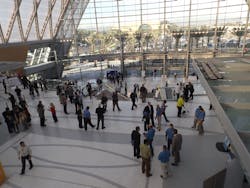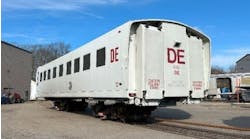When looking at the future of transportation in the city of Anaheim, California, rail transit is going to play a major role.
With growth in Orange County Transportation Authority (OCTA) ridership, Amtrak, Metrolink and other modes of transit in the region, Anaheim needed to plan for a future with rail transit. And with the potential southern terminus for the California High Speed Rail project coming into the city, it meant looking at the future in a big way.
“The city had the idea they really wanted this building to be iconic and to represent rail transportation for the 21st Century,” said Ernest Cirangle, design principal with HOK. “They really wanted to make their mark and show California and show the world that they’re on the forefront of rail transit. We were energized by their idea and mission.”
Anaheim took its big leap forward in addressing future transportation needs and the future of rail transit in the community when it opened the Anaheim Regional Transportation Intermodal Center (ARTIC) in December 2014.
Building a Landmark
Located in the heart of the city near Disneyland stadiums for the Los Angeles Angels of Anaheim and the Anaheim Ducks, the ARTIC station is designed to be a gateway into the community and coordinate travel into one central location.
Joel Zlotnik, manager of public information for OCTA, said previous to ARTIC, the station there was simply a platform in the parking lot of the Angels stadium, which the baseball team wanted for more parking. It also led to very little convenience for bus riders as local buses had to be caught from the street.
The station was primarily funded by revenues from Measure M, which is a half-cent sales tax in Orange County, which goes to pay for transportation improvements. Zlotnik said ARTIC was set forth like all other rail stations in the county, where OCTA helps secure the funds and the local municipality runs the facility.
The area not only unites local bus service, but puts it into a location serving a busy rail corridor. Zlotnik said there are 29 daily trains into the station and 22 Amtrak trips as part of the Pacific Surfliner, which is the second busiest passenger rail corridor in the U.S. behind the Northeast Corridor.
The ARTIC Station replaced the existing Amtrak station in Anaheim, but incorporates more modes of transportation than the old one. Albert Kaneshiro, project manager for HOK, said from early on in the design process the team was working with entities involved with the station to make sure it met their needs.
“Previous to the ARTIC project all the bus lines stopped all over the area,” he said. “It wasn’t centralized. The existing Amtrak station had two buses that got close to the station, but never went right up to it and the bus lines were never a feeder to the Amtrak station. There are 13 bus stops at the ARTIC facility, which includes shuttle buses.”
Virginia Tanzmann, vice president of the transportation facilities division of WSP | Parsons Brinckerhoff, served as project manager during the ARTIC station construction, said more than 20 different firms had to be pulled together for the project, which had been in the planning process for years ahead of time.
In addition to the high drawing venues adjacent to the new station, it also needed to be something the city could turn to keep growth moving in the area.
“That property is part of what’s known as the platinum triangle,” Tanzmann said. “That’s an area designated by the city for further development.”
Cirangle, design principal with HOK, said the firm got involved with the ARTIC project during a design competition and saw what Anaheim was trying to achieve.
“The city took the lead on the designing and building of the station and certainly with the input from OCTA and all our operational folks on how the station integrates the rail system and the buses and the other modes of transit,” Zlotnik said. “We certainly worked closely with them.”
Cirangle said a big part of the ARTIC plan included development of adjacent parking lots in the future, so the design needed to incorporate those plans.
“The surface parking lot will be made available for a mixed-use function, which will link the station back to the city,” he said. “It’s basically set up for a bigger TOD opportunity right around the ARTIC station.”
Exceeding expectations
Cirangle said coming up with the design meant looking to the great rail stations, such as in Europe or the old Penn Station in order to come up with a design that had a grand design that create a civic place.
According to a statement from the city of Anaheim, "ARTIC’s design inspires people about public transit. The station provides a stunning setting for the thousands who use it to commute by train and bus, travel on vacation, get to world-class sports and entertainment, stop in while cycling, shoot TV shows and commercials or take personal photos. This is a true community landmark."
“The city has been talking for decades about this project and I think it was conceived about 20 years ago, so there’s a lot of history behind it for and the people of Anaheim have been planning it for decades all in combination with that excitement of bringing that whole part of town up a notch,” Tanzmann said. “There’s nothing wrong with that area; it’s not a distressed area, it just hasn’t been developed like anything this has the potential of doing.”
Building for the 21st Century also meant looking to new building materials and creating a large, vaulted ceiling along with bringing in lots of natural light.
Cirangle said the roof membrane is Ethylene Tetrafluoroethylene (EFTE) manufactured and installed by Vector Foiltec, which is very lightweight and about one-hundredth the weight of glass material and it captures natural light.
“When we’re talking about the EFTE material, is a pretty common material in Europe and Asia,” Kaneshiro said.
Because it was a new material the city wasn’t familiar with, Kaneshiro said there was a lot of discussion on using it, but after bringing all the stakeholders together from various agencies to determine their goals with the project, they were able to bind everyone together in agreement.
Tanzmann said there was plenty of discussion about the roof material but the evidence proved the rationale for its use.
“The numbers don’t lie,” she said. “It weighs a fraction of that of a normal roof assembly and that alone changes a lot of the math on how much structure of the building is needed, so that alone was very appealing.”
Tanzmann said there were technical challenges bringing all the modes of transportation together at the station, including a walking and cycling path located adjacent the ARTIC side along the Santa Ana River. Crews also had to work on major projects like railroad bridge work while accommodating different mass events, such as baseball games.
“The city wanted an icon, they wanted something very, very special and the wanted it on budget and on schedule and we had to overlay that with the baseball schedule,” she said.
The design also has to be seismically sound given southern California’s proneness to earthquakes while accommodating for moisture and temperature controls within the station. One way it does that, Tanzmann said, is via louvers built into the station that automatically open to help cool the inside of the station.
ARTIC also achieved the U.S. Green Building Council’s LEED Platinum certification for the design elements it incorporates. This includes the inclusion of a storm water runoff system, drought resistant plants, using recycled materials for construction process, low flow plumbing fixtures, photovoltaic arrays, electric vehicle charging stations and the use of a EFTE roof membrane structure.
“We did have a budget and we met it and we did have a schedule and we met it,” Tanzmann said.
Tanzmann said there were no major design changes during the construction period, however, there were changes in code that needed to be addressed when the Federal Transit Authority (FTA) instituted new rules for level boarding in order to allow better access for disabled riders. After making some redesigns they were able to make changes.
Tanzmann said the ARTIC project was a traditional design-bid-build project and during the planning designers and engineers with all contractors looked through suggestions to create a cost effective project meeting goals set by the city of Anaheim.
“Value engineering really is misunderstood as just slashing costs when really it’s properly engineering and looking for areas where it might be possible to do things more efficiently,” Tanzmann said. “It’s really a better way of looking at something to see if we’ve pulled out all the stops and are making this thing as efficient as possible and get the best use of public dollars.”
Since opening, the project has already garnered 30 awards.
“Having the right team just makes all of the difference,” Tanzmann said. “This was a high performance team that also had a high level of cooperation and communication and of course the idea of the project totally grabbed everybody.
“Even our contractor going into construction they were all jazzed about it too. It wasn’t just another project for anybody.”






